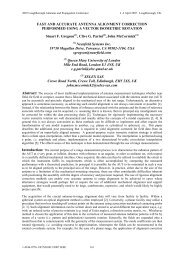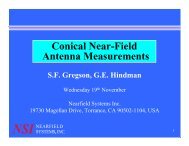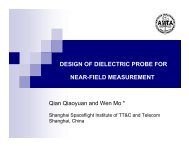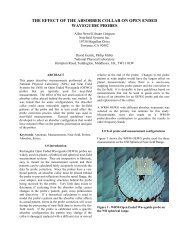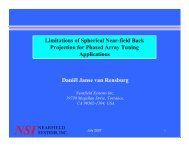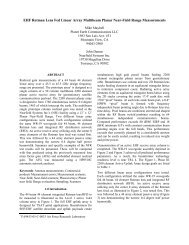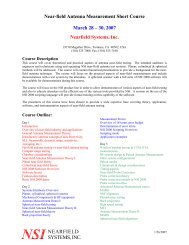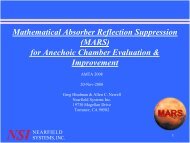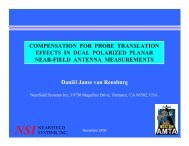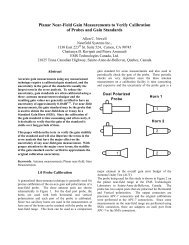reflection suppression to improve anechoic chamber performance
reflection suppression to improve anechoic chamber performance
reflection suppression to improve anechoic chamber performance
You also want an ePaper? Increase the reach of your titles
YUMPU automatically turns print PDFs into web optimized ePapers that Google loves.
2. MARS Description<br />
The purpose of the MARS approach is <strong>to</strong> reduce the<br />
influence of scattering on far-field pattern results. We<br />
use a mathematical post processing technique that<br />
requires a minimum amount of detailed information about<br />
the AUT, probe and antenna range geometry. The<br />
processing is applied during regular near-field <strong>to</strong> far-field<br />
processing. The technique is general enough <strong>to</strong> apply <strong>to</strong><br />
different types of spherical measurement geometries and<br />
<strong>to</strong> different antenna types. NSI has developed a<br />
mathematical opera<strong>to</strong>r that is applied <strong>to</strong> the measured data<br />
that helps <strong>to</strong> distinguish between the correct antenna<br />
properties and scattering. Successful processing requires<br />
more measured data than for the AUT without scattering<br />
for best <strong>performance</strong> - typically requires one half the<br />
spacing in theta and phi than recommended by sampling<br />
criteria. This will usually require about double the test<br />
time, compared <strong>to</strong> normal measurements.<br />
3. Testing antenna in 3 different systems<br />
We will compare test results – patterns, directivity, and<br />
beam-widths from measurements of a NSI-RF-SG284<br />
measured on 3 different spherical NF antenna ranges over<br />
a frequency range of 2.6 <strong>to</strong> 3.95 GHz. The range<br />
configurations are summarized in the table below:<br />
Figure Type Location NSI Scanner Absorber<br />
Figure 4 – NSI-RF-SG284 gain horn tested at NSI on<br />
NSI-700S-90 ARCH Spherical NF in open<br />
environment with NO <strong>anechoic</strong> <strong>chamber</strong> – notice<br />
ripple in pattern at about -25 dB level due <strong>to</strong> range<br />
<strong>reflection</strong>s<br />
#1 Chamber Cus<strong>to</strong>mer NSI-700S-50 12” pyramid<br />
#2 Chamber NSI NSI-700S-60 8” pyramid<br />
#3 Open lab NSI NSI-700S-90 NONE!<br />
All the ranges are running NSI2000 Data acquisition and<br />
processing software, and we used the Agilent PNA for<br />
the RF subsystem. Data in the cus<strong>to</strong>mer facility was<br />
measured using a NSI-RF-WR284 open ended waveguide<br />
probe, and the data in the other two ranges was measured<br />
using an NSI dual-port probe. Range positioner axis<br />
alignment was performed using NSI’s electrical<br />
alignment technique documented in [3] [4] [5].<br />
Figures 4 shows the near-field measured data of the SGH<br />
on the 700S-90 arch range with no absorber or <strong>chamber</strong>,<br />
using NSI’s 3-D field viewer. One can easily see the<br />
ripple in the 3-D display and pattern cuts at about the -25<br />
dB level due <strong>to</strong> range <strong>reflection</strong>s. In figure 5, we show<br />
the result in NSI-s 700S-60 scanner in the <strong>anechoic</strong><br />
<strong>chamber</strong> at NSI, and the reduced <strong>reflection</strong>s are apparent.<br />
Figure 5 – NSI-RF-SG284 gain horn tested at NSI on<br />
NSI-700S-60 Spherical NF in <strong>chamber</strong><br />
298



